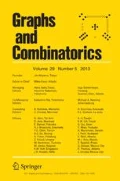Abstract
Graph burning is a discrete-time process on graphs, where vertices are sequentially burned, and burned vertices cause their neighbours to burn over time. We consider extremal properties of this process in the new setting where the underlying graph is also changing at each time-step. The main focus is on the possible densities of burning vertices when the sequence of underlying graphs are growing grids in the Cartesian plane, centred at the origin. If the grids are of height and width \(2cn+1\) at time n, then all values in \(\left[ \frac{1}{2c^2} , 1 \right] \) are possible densities for the burned set. For faster growing grids, we show that there is a threshold behaviour: if the size of the grids at time n is \(\omega (n^{3/2})\), then the density of burned vertices is always 0, while if the grid sizes are \(\varTheta (n^{3/2})\), then positive densities are possible. Some extensions to lattices of arbitrary but fixed dimension are also considered.

Similar content being viewed by others
References
Benevides, F.S., Przykucki, M.: On slowly percolating sets of minimal size in bootstrap percolation. Electron. J. Comb. 20, 1–20 (2013)
Benevides, F.S., Przykucki, M.: Maximum percolation time in two-dimensional bootstrap percolation. SIAM J. Discret. Math. 29, 224–251 (2015)
Bessy, S., Bonato, A., Janssen, J., Rautenbach, D., Roshanbin, E.: Burning a graph is hard. Discret. Appl. Math. 232, 73–87 (2017)
Bessy, S., Bonato, A., Janssen, J., Rautenbach, D., Roshanbin, E.: Bounds on the burning number. Discret. Appl. Math. 235, 16–22 (2018)
Bonato, A., Janssen, J., Roshanbin, E.: Burning a graph as a model of social contagion. Lect. Notes Comput. Sci. 8882, 13–22 (2014)
Bonato, A., Janssen, J., Roshanbin, E.: How to burn a graph. Internet Math. 12, 85–100 (2016)
Bonato, A., Kamali, S.: Approximation and algorithms for burning graphs. Lect. Notes Comput. Sci. 11436, 74–92 (2019)
Bonato, A., Lidbetter, T.: Bounds on the burning numbers of spiders and path-forests. Theoret. Comput. Sci. 794, 12–19 (2019)
Boyd, S., Ghosh, A., Prabhakar, B., Shah, D.: Randomized gossip algorithms. IEEE Trans. Inf. Theory 52, 2508–2530 (2006)
Cai, L., Wang, W.: The surviving rate of a graph for the firefighter problem. SIAM J. Discret. Math. 23, 1814–1826 (2009)
Finbow, S., MacGillivray, G.: The firefighter problem: a survey of results, directions and questions. Australas. J. Comb. 43, 57–77 (2009)
Fitzpatrick, S.L., Wilm, L.: Burning circulant graphs. Preprint (2018)
Granovetter, M.: Threshold models of collective behavior. Am. J. Sociol. 1420–1443 (1978)
Hammersley, J.M., Welsh, D.J.A.: First-passage percolation, subadditive processes, stochastic networks, and generalized renewal theory. In: Neyman, J., LeCam, L.M. (eds.) Bernoulli 1713 Bayes 1763 Laplace 1813, pp. 61–110. Springer, Berlin (1965)
Harris, T.E.: Contact interactions on a lattice. Ann. Probab. 2, 969–988 (1974)
Hartnell, B.L.: Firefighter! an application of domination. In: Presentation at 25th Manitoba Conference on Combinatorial Mathematics and Computing, University of Manitoba in Winnipeg, MB (1995)
Kramer, A.D.I., Guillory, J.E., Hancock, J.T.: Experimental evidence of massive-scale emotional contagion through social networks. Proc. Natl. Acad. Sci. USA 111, 8788–8790 (2014)
Land, M., Lu, L.: An upper bound on the burning number of graphs. In: Algorithms and models for the web graph, pp. 1–8. Springer, Cham (2016)
Mitsche, D., Prałat, P., Roshanbin, E.: Burning graphs—a probabilistic perspective. Graphs Comb. 33, 449–471 (2017)
Przykucki, M.: Maximal percolation times in hypercubes under 2-bootstrap percolation. Electron. J. Comb. 19, 1–13 (2012)
Richardson, D.: Random growth in a tessellation. Math. Proc. Camb. Philos. Soc. 74, 515–528 (1973)
Roshanbin, E.: Burning a graph as a model of social contagion. PhD thesis, Dalhousie University, Halifax, NS (2016)
Schelling, T.: Micromotives and Macrobehavior. Norton, New York (1978)
Acknowledgements
The authors would like to thank the referee for their very careful reading of the paper and the many helpful suggestions which greatly improved a number of the proofs.
Author information
Authors and Affiliations
Corresponding author
Additional information
Publisher's Note
Springer Nature remains neutral with regard to jurisdictional claims in published maps and institutional affiliations.
AB and KG supported by NSERC Discovery grants.
Rights and permissions
About this article
Cite this article
Bonato, A., Gunderson, K. & Shaw, A. Burning the Plane. Graphs and Combinatorics 36, 1311–1335 (2020). https://doi.org/10.1007/s00373-020-02182-9
Received:
Revised:
Published:
Issue Date:
DOI: https://doi.org/10.1007/s00373-020-02182-9




